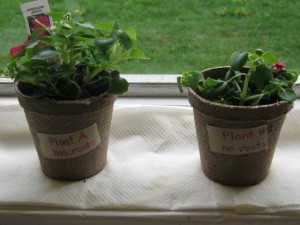The past two weeks have been busy, and fun-filled, with learning about plants. We have done several experiments with existing plants to determine the use that plants have for their different parts. We have also planted some seeds of our own which we are anxiously awaiting to sprout.
The first experiment we did was taking a small plant apart and looking at its various parts. Students saw how the roots form a ‘ball’ in the soil and that when the soil is carefuly removed the roots are long and delicate. We closely examined the stem and its many branches and saw buds forming amongst the leaves. The students know that these buds develop into the plant’s flowers. We then re-potted the plant.
For our second experiment we put celery in water with food colouring. We had one water-glass coloured with blue and one with red. We left some celery in a jar of water with no food colouring in it, as well. We also put one white flower in a jar with green food colouring. We left these to sit on the window ledge overnight. The next day we saw this:
We cross-cut some parts off the bottom of the celery stems to see the straw-like tubes that form the stem of the celery. Students discovered that plants have these tubes in their stems to draw up water from the ground to the other parts of the plant. They could tell that the celery had drawn up the water as the leaves at the top had changed colour.
Our third experiment was focussed on the need a plant has for its root system. We took two plants and transplanted one – in its entirety – into a new, larger pot. With the second plant we cut it from its roots at the dirt level and then ‘planted’ it into a new pot filled with soil. We recorded how they both initially looked (through drawings) and we will re-visit them next week to record any differences. The next day we already noticed some changes in the ‘rootless’ plant.
Just to see what might happen, we also re-potted the root system that we cut off into a third pot. All three of these pots are sitting in the window ledge and are being watered regularly. We will be watching them each day to note any changes.
We have planted nasturtium seeds into clay pots that the students collaged with tissue paper and which were sealed with Mod Podge (similar to acrylic medium). We are hoping to see some greenery sprouting this week.
We have also got two avocado pits suspended in water glasses – one with the pointy end down and the other with the rough end in the water. Students made predictions as to which pit will sprout roots. This will take a number of weeks so we will just have to be patient and wait.
We will be continuing our plant unit over the next few weeks and look forward to making more discoveries.



